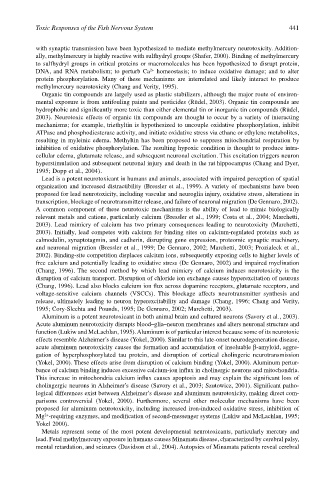Page 461 - The Toxicology of Fishes
P. 461
Toxic Responses of the Fish Nervous System 441
with synaptic transmission have been hypothesized to mediate methylmercury neurotoxicity. Addition-
ally, methylmercury is highly reactive with sulfhydryl groups (Shafer, 2000). Binding of methylmercury
to sulfhydryl groups in critical proteins or macromolecules has been hypothesized to disrupt protein,
2+
DNA, and RNA metabolism; to perturb Ca homeostasis; to induce oxidative damage; and to alter
protein phosphorylation. Many of these mechanisms are interrelated and likely interact to produce
methylmercury neurotoxicity (Chang and Verity, 1995).
Organic tin compounds are largely used as plastic stabilizers, although the major route of environ-
mental exposure is from antifouling paints and pesticides (Rüdel, 2003). Organic tin compounds are
hydrophobic and significantly more toxic than either elemental tin or inorganic tin compounds (Rüdel,
2003). Neurotoxic effects of organic tin compounds are thought to occur by a variety of interacting
mechanisms; for example, triethyltin is hypothesized to uncouple oxidative phosphorylation, inhibit
ATPase and phosphodiesterase activity, and initiate oxidative stress via ethane or ethylene metabolites,
resulting in myleinic edema. Methyltin has been proposed to suppress mitochondrial respiration by
inhibition of oxidative phosphorylation. The resulting hypoxic condition is thought to produce intra-
cellular edema, glutamate release, and subsequent neuronal excitation. This excitation triggers neuron
hyperstimulation and subsequent neuronal injury and death in the rat hippocampus (Chang and Dyer,
1995; Dopp et al., 2004).
Lead is a potent neurotoxicant in humans and animals, associated with impaired perception of spatial
organization and increased distractibility (Bressler et al., 1999). A variety of mechanisms have been
proposed for lead neurotoxicity, including vascular and neuroglia injury, oxidative stress, alterations in
transcription, blockage of neurotransmitter release, and failure of neuronal migration (De Gennaro, 2002).
A common component of these neurotoxic mechanisms is the ability of lead to mimic biologically
relevant metals and cations, particularly calcium (Bressler et al., 1999; Costa et al., 2004; Marchetti,
2003). Lead mimicry of calcium has two primary consequences leading to neurotoxicity (Marchetti,
2003). Initially, lead competes with calcium for binding sites on calcium-regulated proteins such as
calmodulin, synaptotagmin, and cadherin, disrupting gene expression, proteomic synaptic machinery,
and neuronal migration (Bressler et al., 1999; De Gennaro, 2002; Marchetti, 2003; Prozialeck et al.,
2002). Binding-site competition displaces calcium ions, subsequently exposing cells to higher levels of
free calcium and potentially leading to oxidative stress (De Gennaro, 2002) and impaired myelination
(Chang, 1996). The second method by which lead mimicry of calcium induces neurotoxicity is the
disruption of calcium transport. Disruption of chloride ion exchange causes hyperexcitation of neurons
(Chang, 1996). Lead also blocks calcium ion flux across dopamine receptors, glutamate receptors, and
voltage-sensitive calcium channels (VSCCs). This blockage affects neurotransmitter synthesis and
release, ultimately leading to neuron hyperexcitability and damage (Chang, 1996; Chang and Verity,
1995; Cory-Slechta and Pounds, 1995; De Gennaro, 2002; Marchetti, 2003).
Aluminum is a potent neurotoxicant in both animal brain and cultured neurons (Savory et al., 2003).
Acute aluminum neurotoxicity disrupts blood–glia–neuron membranes and alters neuronal structure and
function (Lukiw and McLachlan, 1995). Aluminum is of particular interest because some of its neurotoxic
effects resemble Alzheimer’s disease (Yokel, 2000). Similar to this late-onset neurodegeneration disease,
acute aluminum neurotoxicity causes the formation and accumulation of insoluable β-amyloid, aggre-
gation of hyperphosphorylated tau protein, and disruption of cortical cholingeric neurotransmission
(Yokel, 2000). These effects arise from disruption of calcium binding (Yokel, 2000). Aluminum pertur-
bance of calcium binding induces excessive calcium-ion influx in cholinergic neurons and mitochondria.
This increase in mitochondria calcium influx causes apoptosis and may explain the significant loss of
cholingergic neurons in Alzheimer’s disease (Savory et al., 2003; Szutowicz, 2001). Significant patho-
logical differences exist between Alzheimer’s disease and aluminum neurotoxicity, making direct com-
parisons controversial (Yokel, 2000). Furthermore, several other molecular mechanisms have been
proposed for aluminum neurotoxicity, including increased iron-induced oxidative stress, inhibition of
2+
Mg -requiring enzymes, and modification of second-messenger systems (Lukiw and McLachlan, 1995;
Yokel 2000).
Metals represent some of the most potent developmental neurotoxicants, particularly mercury and
lead. Fetal methylmercury exposure in humans causes Minamata disease, characterized by cerebral palsy,
mental retardation, and seizures (Davidson et al., 2004). Autopsies of Minamata patients reveal cerebral

